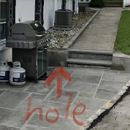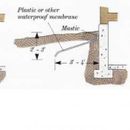Correct foundation drainage before starting project
So I asked several questions about drainage near basement wall just want to make sure I’m doing this correctly before I start this project. I’m going to dig a 20 foot long trench, 2 ft deep about 3 feet from foundation wall. Im going to grade a 2 inch slope from foundation wall so water is diverted into trench. I’m going to drop a French drain in trench and punch 4in hole in concrete wall at bottom of pitched pipe to stick pvc pipe through to drain water (see attached picture). This is where I get confused and have a few questions
1. Should I attach 6mil poly sheet a few inches up foundation wall and cover slope with poly (Diagram attached). If I do this do I put soil or gravel above this, if soil how many inches on top of plastic.
2. patio slopes about 1 inch down into backyard. You can see from picture everything is sloped. Will everything down low be flooded? Is this too much water to divert down? Is there a better place to divert water without ripping up patio? I can create another drain before water hits backyard as an option
3. Do I want to use a drywell instead I’m assuming 3 feet from home would still cause water to deep into ground and into basement floor.
GBA Detail Library
A collection of one thousand construction details organized by climate and house part











Replies
Hi Joe.
It seems that your plan is to drain water onto your patio? Do I have that correct? If so, I think that is a bad idea. You need to get water away from the house, whether to daylight or a dry well, or a sump with a pump, get the water away from the house or it will likely find another way in.
Also, if you are not able to dig deep enough to retrofit or fix your footing drains, consider the technique for underground gutters shown towards the end of this article, it's the best variation on this idea that I have seen: Best Practices for Dry, Healthy Basements
I can’t get this link to work?
Sorry about that; It should work now, Tom.
Brian thanks for your response, and you are right that water draining on my patio would be a bad idea. I like your idea of an underground gutter to solve footing draining. Could I connect a 90 degree bend at end of trench to send water to a drywell that is about 10 feet from house? That is the furthest I can go without jack hammering up entire concrete. I would have to tunnel under a sidewalk to get to drywell which I believe is doable. Can you or anyone else give me an idea of how to tunnel under my AC condenser? Could I temporarily support it underneath so I can dig out, is it possible just to dig a tunnel there for pipe to get through and continue with rest of trench. What membrane would be good to line foundation wall and trench?
Hi Joe.
EPDM pond liners are pretty common. If you can't find it locally, you can definitely get it online. You could also use thick polyethylene sheeting to line the trench. In the trench, you should use perforated pipe. If you turn it towards a dry well, you can use solid pipe after the bend. The easiest thing may be to have the A/C unit moved while you do the work. Maybe someone else has an idea for how to work around (or below) it. There are tools you could rent to tunnel under the sidewalk, but as Jon says below, it may be easier to remove and replace a section.
Brian they sell 6 mil sheeting locally and pvc pond liner, I’m assuming thats not epdm, at big box stores. The lumber yard might have it or I could order it online, is there a performance difference? If so I will get whatever is better. Do I have to somehow attach this sheeting directly to wall as well? What would be the best way and most efficient? There is a small gap between wall and ac condenser. Article says you should put pipe directly under drip line of roof but also said that might not even matter. If it can be in trench but close enough to wall then I can leave trench thinner just under ac condenser and slip pipe in. Technically if rain drops over condenser it will end up inside or rolling off behind or sides. I will put some stone on front of condenser to weigh it down in case it starts leaning back from missing dirt. Do I really need a machine to tunnel under sidewalk? This guy on YouTube did it with a shovel https://youtu.be/MDUbMXlYP30
You certainly do not need a boring tool, just makes it easier and keep in mind that your pipe will be running significantly lower than the tunnel in that video, I think. That's why I felt that removing a section of concrete may be easiest. This is totally your preference.
I would guess that any pond liner would work for you and would be more robust than 6 mil poly. You may be able to attach it to the concrete with a sealant, or you can mechanically fasten it with screws or nails through horizontal battens, or both, for a belt-and-suspenders approach.
This prob won’t apply to my situation but the thought ran across my mind of just making this area concrete, searched and saw something on YouTube about it https://youtu.be/yJ4IeLiQ8es
How come I never see this done, would it trap moisture? I’m pretty sure I couldn’t apply this to my situation. Only thought is ripping up sidewalk and placing stepping stones instead sloping walkway right into soil area. I would even cut gutters to slope here since I don’t even know where they are going
I wouldn't rule out removing a section of the sidewalk and then replacing it (with either new concrete or the same piece).